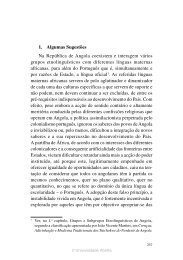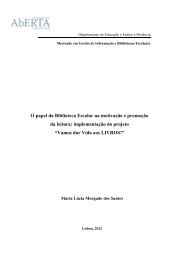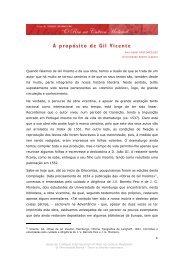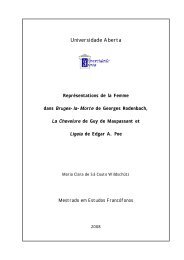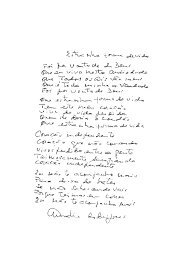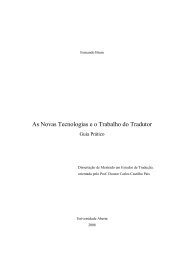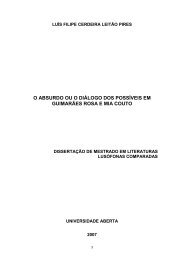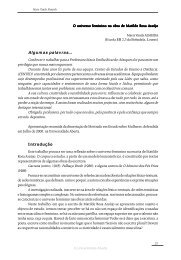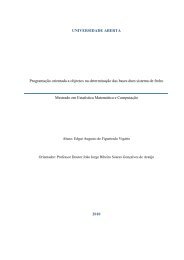Diálogos Transdisciplinares em Girl with a Pearl Earring: a Arte ...
Diálogos Transdisciplinares em Girl with a Pearl Earring: a Arte ...
Diálogos Transdisciplinares em Girl with a Pearl Earring: a Arte ...
You also want an ePaper? Increase the reach of your titles
YUMPU automatically turns print PDFs into web optimized ePapers that Google loves.
Chevalier vê na Câmara Escura um estratag<strong>em</strong>a para interpretar formas exteriores<br />
que expressam uma realidade interior, incluindo as intenções do artista. Na análise<br />
de Cibelli:<br />
In assessing the naturalistic outer forms, the viewer is to analyze the figures in<br />
Vermeer’s paintings for signs of their interior thoughts so that their <strong>em</strong>otions or<br />
passions can be contrasted <strong>with</strong> ideals of the time period. The camera obscura is<br />
paradigmatic of her technique of describing the social context and the personality<br />
of moral dimension of the characters (588)<br />
Cativado pelo seu jeito quieto e ingênuo, e pela sua intuição e fascínio pela arte,<br />
Vermeer leva Griet aos poucos para seu mundo – um lugar calmo, de cores<br />
exóticas e luz ofuscante, sombras que mudam e uma beleza inimaginável, - e <strong>em</strong><br />
segredo, decide torná-la sua ajudante, ensinando-a preparar a moer e misturar as<br />
tintas para suas pinturas. Griet que antes já se d<strong>em</strong>orava a olhar os quadros do<br />
pintor, passa assim a acompanhar as suas criações desde o início:<br />
“ I had never seen a painting made from the beginning. I thought that you painted<br />
what you saw, using the colours you saw. He taught me” (106).<br />
,analisa o método utilizado por Vermeer com a seguinte interpretação:<br />
He began a painting of the baker’s daughter <strong>with</strong> a layer of pale grey on the white<br />
canvas. Then he made reddish-brown all over it to indicate where the girl and the<br />
table and pitcher and window and map would go. After that I thought he would<br />
begin to paint what he saw – a girl’s face, a blue skirt, a yellow and black bodice,<br />
a brown map, a silver pitcher and basin, a white wall. Instead he painted patches<br />
of colour –black where her skirt would be, ochre for it sat in, another grey of the<br />
wall, red for the pitcher and the basin none was the colour of the thing itself. He<br />
spent a long time on these false colours, as I called th<strong>em</strong>” (106).<br />
e modifica a sua composição, quando muda à colocação de determinados objetos:<br />
“Once it was clear to me what he should do to the scene, I waited for him to make<br />
the change. … He did not move anything on the table. ... As I lay in bed one night<br />
I decided I would have to make the change myself. … Then in one quick<br />
mov<strong>em</strong>ent I pulled the front part of the blue cloth on to the table so that it flowed<br />
out of the dark shadows under the table and up in slant on to the table in front of<br />
the jewellery box. I made a few adjustments to the lines of the folds, then stepped<br />
back. It echoed the shape of van Ruijven’s wife’s arm as she rested it on the table.



